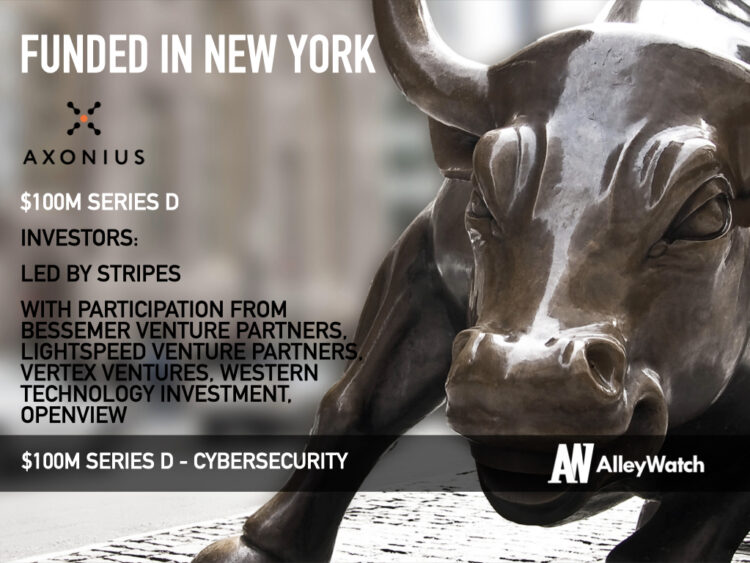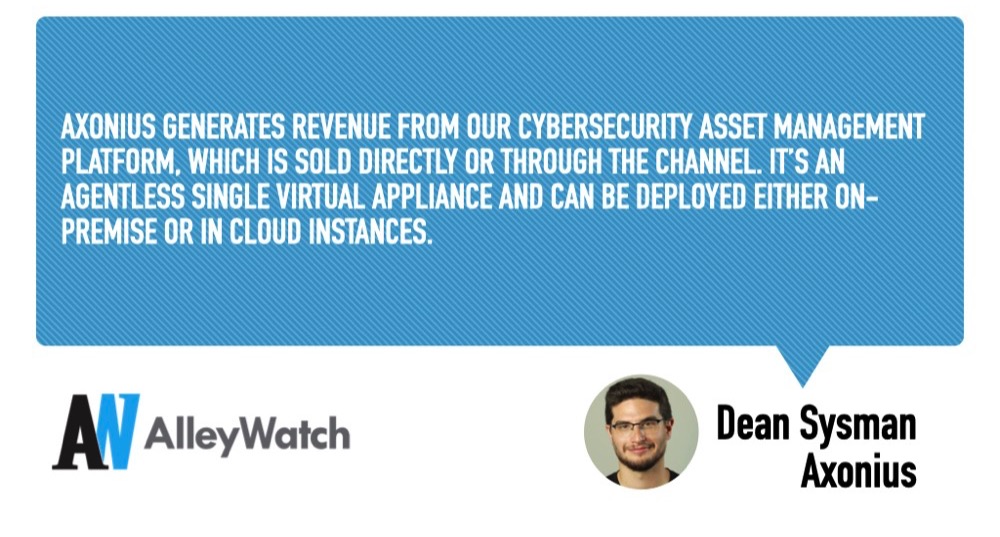According to IBM, the average cost of a data breach is $4M but only 29% of businesses have a cybersecurity expert on their IT team. As businesses use more and more data and as employees use more devices (the average employee now uses 2.3 devices), the potential liability increases each day. Axonius’ cybersecurity asset management platform gives enterprises a full inventory of their assets and ensures that these devices are properly being secured. The platform takes a holistic approach by integrating into existing cybersecurity tools and workflows and ensuring that all devices being used (whether physical or virtual) are compliant with the company’s security protocols. Founded by former intelligence officers from the Israeli Defense Force, the platform solves the fragmentation problem found in enterprises when it comes to security. Axonius is trusted by companies like The New York Times, Schneider Electric, and AB InBev.
AlleyWatch caught up with CEO and Cofounder Dean Sysman to learn more about the complexities in managing sound cybersecurity policies throughout an enterprise, the company’s future plans, and latest round of funding, which brings the total funding raised to $195M.
Who were your investors and how much did you raise?
Axonius raised $100 million in Series D funding, led by Stripes, a leading New York-based growth equity firm, as well as participation from existing investors Bessemer Venture Partners (BVP), OpenView, Lightspeed, and Vertex. Ken Fox, founder and partner at Stripes, will join the Axonius board of directors. This latest round follows a 2020 investment of $58 million, increasing total funding to $195 million at a greater than $1 billion valuation.
 Tell us about the product or service that Axonius offers.
Tell us about the product or service that Axonius offers.
Axonius is the first and only cybersecurity asset management platform that gives organizations a comprehensive asset inventory, uncovers security solution coverage gaps, and automatically validates and enforces security policies. Axonius has adapters for more than 300 tools and counting, including public cloud providers, endpoint protection tools, configuration management databases (CMDBs), vulnerability scanners, identity and access solutions, firewalls, security information and event management (SIEM) solutions, and deception solutions. If a customer is using a tool that can provide data about assets, Axonius has likely built an API connection for it. Axonius makes all other IT and cybersecurity tools stronger. By connecting to each of the tools within an organization and correlating the data, Axonius is able to fill in gaps from each class of tools while ensuring each product has full coverage.
What inspired the start of Axonius?
We started Axonius in 2017 to solve one of the most basic yet pervasive problems in cybersecurity. Despite organizations having on average around 108 cybersecurity tools in their arsenal, it’s incredibly difficult for them to answer simple questions about the devices, users, and cloud instances they are tasked with securing. Asset management is so foundational, yet it’s a nagging problem that is only getting worse. Along with my cofounders Ofri Shur and Avidor Bartov, I am a veteran of an elite intelligence unit of the Israeli Defense Force. We built Axonius to solve the asset management challenge for cybersecurity.
How is Axonius different?
Many solutions are used to discover and manage assets; however, they are often siloed and outdated, and they lack the context and data needed to help security teams answer fundamental questions, such as: What is the asset? What software is running on the asset? Does the asset adhere to or deviate from company security policies? By connecting to all data sources that know about assets, Axonius is the only platform that discovers all assets and automatically correlates data to deliver a credible, always up-to-date asset inventory.
Unlike other platforms, Axonius deploys across even the most complex environments in hours (not days) with an agentless architecture and continuously discovers all assets, regardless of where they are located and how long they are used. This includes unmanaged devices (such as IoT and BOYD devices), ephemeral devices (virtual machines and cloud workloads), and OT devices. Axonius automatically notifies, enriches, and alerts the right teams whenever an asset doesn’t meet your specific security policies.
What market does Axonius target and how big is it?
Axonius sells to security teams across all verticals. In less than two years from launch, we surpassed 100 customers, including many global leaders, such as AB InBev, Schneider Electric, and The New York Times. In 2020, Axonius launched an aggressive channel partner program, working strategically with top-tier partners and adding nearly 70 global partners in less than a year. From a vertical standpoint, we are gaining traction in technology, healthcare, retail, tech, and financial services. The team is also working with the largest federal agencies representing significant deals. Axonius is listed on CDM APL, SEWP, and GSA and has federal deployments that encompass more than 3.5 million devices.
What’s your business model?
Axonius generates revenue from our Cybersecurity Asset Management Platform, which is sold directly or through the channel. It’s an agentless single virtual appliance and can be deployed either on-premise or in cloud instances.
How has COVID-19 impacted the business?
During the pandemic, we have seen massive growth fueled by companies around the world needing to secure the work-from-anywhere environment we live in. Last year, we achieved triple-digit annual recurring revenue growth and doubled our staff.
What was the funding process like?
The most important thing to make the process as smooth and successful as possible is to remember to put yourself in the investors’ shoes, see things the way they do, and understand their incentives and concerns. Also, it’s important not to over-optimize, as much as it feels like a very strategic thing. It’s better just to get it done and focus on running and growing the business.
What are the biggest challenges that you faced while raising capital?
The current climate is very chaotic in terms of valuations and just the sheer amount of money in the market. Don’t take money without realizing the consequences, and make sure to understand that fundraising isn’t success in its own right.
The current climate is very chaotic in terms of valuations and just the sheer amount of money in the market. Don’t take money without realizing the consequences, and make sure to understand that fundraising isn’t success in its own right.
What factors about your business led your investors to write the check?
We’re a fast-growing, innovative, and category-creating company. We’re committed to solving a fundamental problem in cybersecurity with an easy-to-use, powerful platform that collects and correlates data from hundreds of cybersecurity products.
What are the milestones you plan to achieve in the next six months?
We’re on track to continue to meet our company goals in sales, product, user experience, and most importantly, our employees’ happiness and growth.
What advice can you offer companies in New York that do not have a fresh injection of capital in the bank?
Think smart and in a mature way about capital efficiency and the long-term planning of risk around burn.
Where do you see the company going now over the near term?
We will use the new funding to scale company growth globally and expand our cybersecurity asset management platform to meet surging market demand while maintaining our commitment to product simplicity and customer value.
What’s your favorite outdoor dining restaurant in NYC?
It doesn’t have an outdoor section, but I have to mention it regardless: Zuma!






